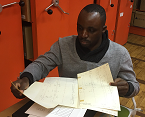Ronald Kibirige is a PhD candidate at the Norwegian University of Science and Technology. His PhD research engages with a dance tradition, Lamokowang, of the Acholi people in the post-conflict Acholi Sub-region of Northern Uganda. With mobility support from ATTR, Kibirige made two research trips between May and July 2019, one to the Institute for Musicology, and one to his research community. Here is his report.
Dance as reconciliation
I investigate the tradition and the “being” of its dancing and dance-musicking to explicate its functionalities that site and mitigate communal challenges of reconciliation and social-cultural re/integration.
As part of my analysis, I use the Laban system of dance notation (Kinetography), which is also at the center of the Institute for Musicology, Research Center for Humanities, Hungarian Academy of Science, in Budapest.
My interaction at the Academy included an exploration of notation techniques, through reviewing earlier manuscripts, as well as interacting with notation specialist Janos Fügedi. I specifically focused on the intent of the usage of specific notation symbols, which impacted on their usage in the analysis of the movement patterns of the Lamokowang tradition.
Adjusting the plans
Following the award of the ATTR grant of 35,000 NOK (less than I applied for), and after adjusting my plans from a longer to a shorter stay and limited travel, I set out to visit the above institution in May 2019.
I prioritised my visit to Hungary over the rest as the fund prescribed. I only made one trip to Uganda in July and mostly spent time in my research community in what, in my methodology, I referred to as a validation process, after my research visit to Hungary.
In this research period, I visited the notation archive, reviewed old scores, interacted with the notation specialists of the Institute and thereafter made a validation trip to my research
community in Northern Uganda.
Reviewing earlier manuscripts to explore notation techniques
My interaction at the archive engaged the Laban system of dance notation (Kinetography). I looked at and analysed old scores of Hungarian legend Rudolf Laban and his predecessors. I reviewed scores and manuscripts from the early 1920s, while looking at the application of the system today. This helped me to look at the chronological development of the symbols and some views of and development by the International Council for Kinetography Laban.
I specifically focused on the intent of the usage of specific notation symbols, which impacted
on their usage in my dissertation. With Prof. Janos, we experimented some attributions to the
system and their possible extension to adapt their practical principles to traditional dance
material from East Africa as part of my Doctoral studies. For there are bodily representations
in the dance tradition that need extension and development of new terminologies, symbols as well as working theories. This interaction was pivotal to the process of building onto what
already exists (authoritative textural knowledge) for this and other dance tradition is Uganda.
Svikt analysis
One of the main results of this experimentation on the usage of symbols was in relation to the representation of a vertical pulsation of the body as referred to by the Hungarian dance
notation school of thought, and prevalent in the tradition I am investigating (Lamokowang). It
is also what Norwegian Ethnochoreologists refer to as the Svikt, onto which they developed what is referred to as the Svikt analysis.
The analogy of this representation, in my dissertation, grounds what I have referred to as wave-like motion of the upper body in the enaction of the five main movement patterns in my analysis chapter, especially the Yenge dance movement pattern. Through the interactions, I was able to re-affirm this phenomenal representation and to further inform my analysis, as well as have a possible wider view by looking at a myriad of earlier notation manuscripts and their notation experts.
The institute’s archive includes many sections which complement and (or) build on dance and dancing as embodied knowledge. I spent most of my time in the notation section of the
archive, as I wanted to focus more on the analysis section of my dissertation.
Momentum for completion
As outlined in my methodology, with this fund, I was able to do further validation of these
phenomena with the dance practitioners in my research community - the bearers of the Dance knowledge and tradition I am engaged with.
I experimented with the system and its extensions to adapt its practical principles to traditional dance material in my Doctoral thesis. The research stays have greatly enriched my PhD project, and have increased my momentum for a successful completion.
I strongly believe that these research visits have greatly enriched my PhD project and have given me considerable momentum for completion.
